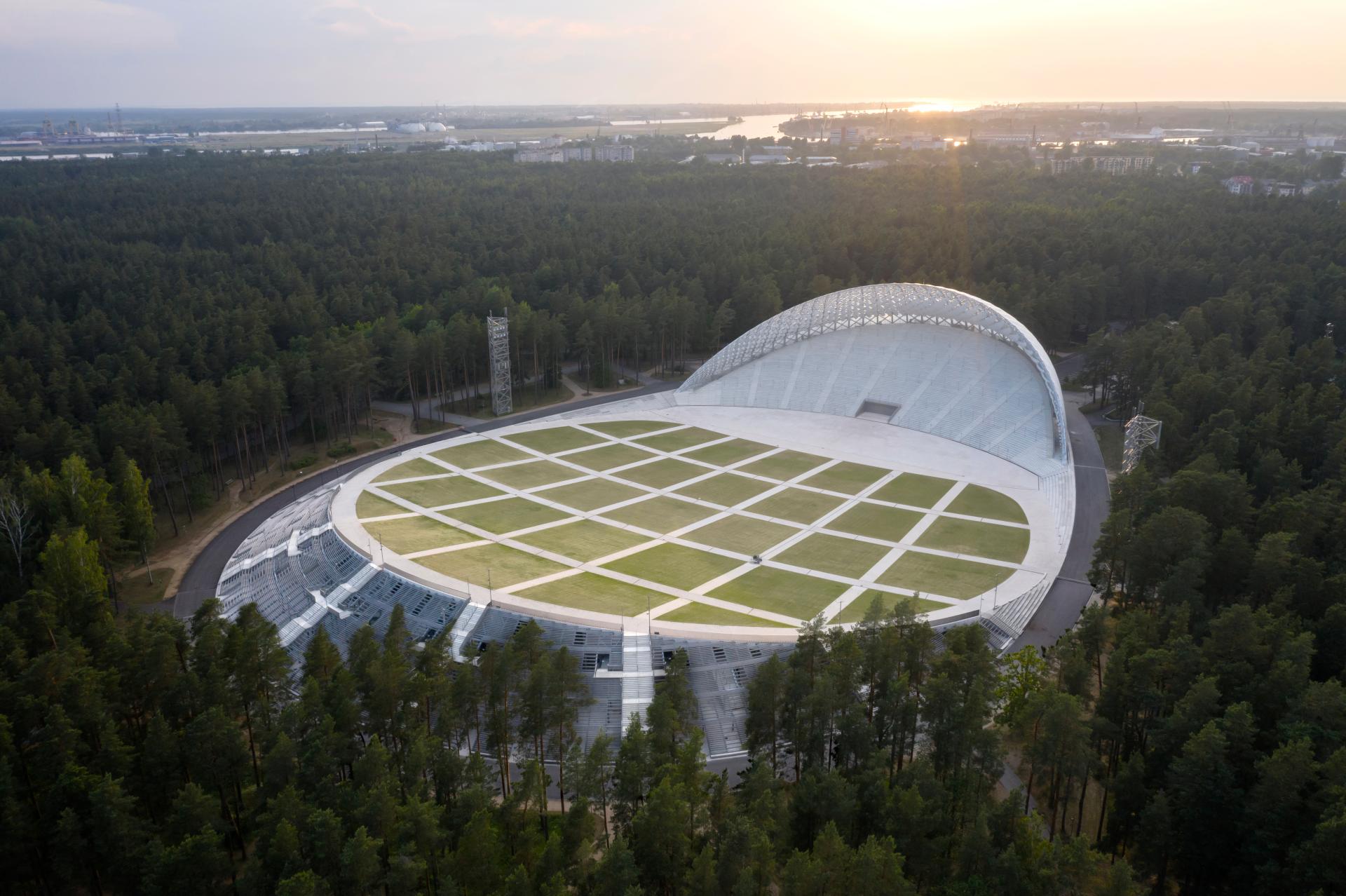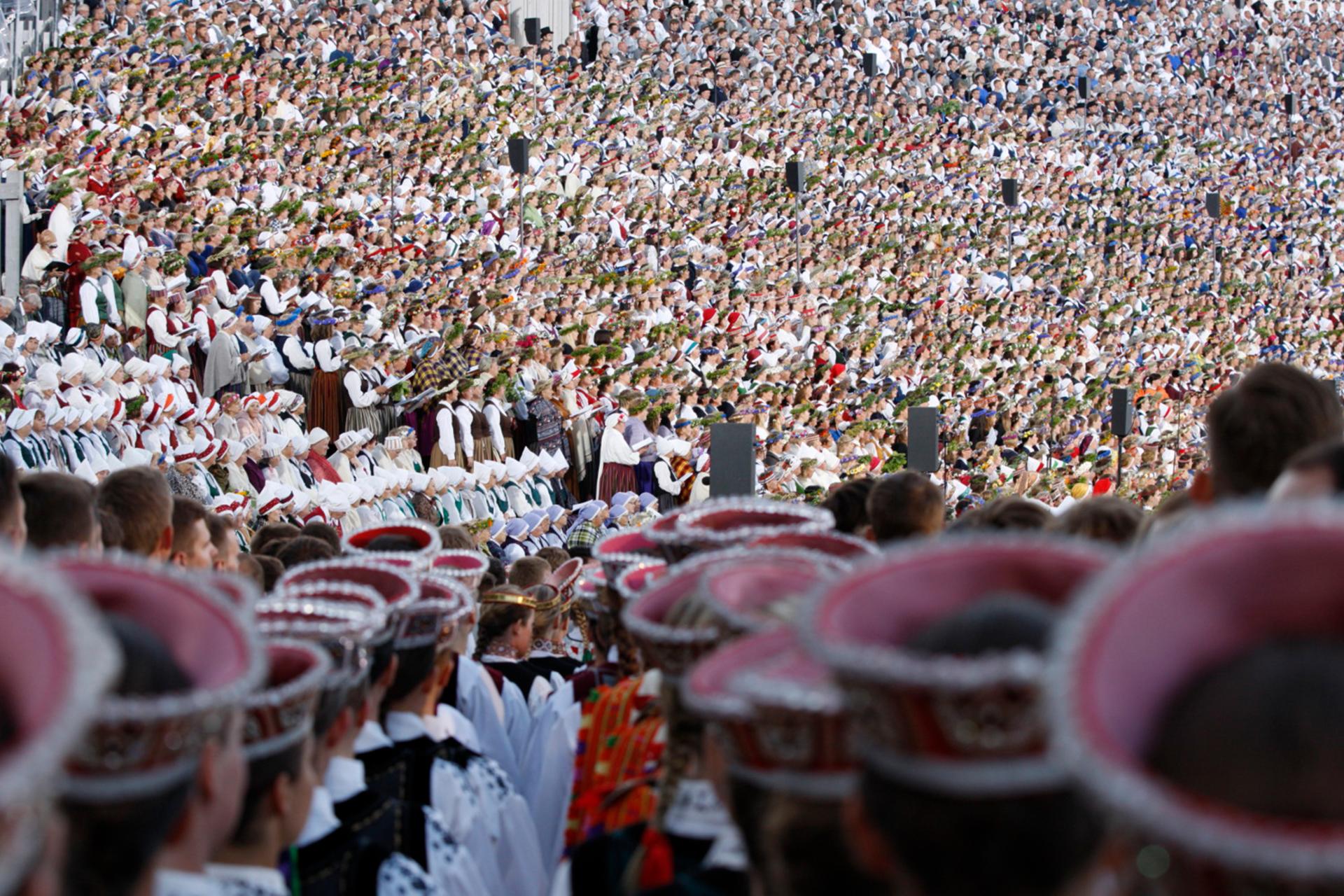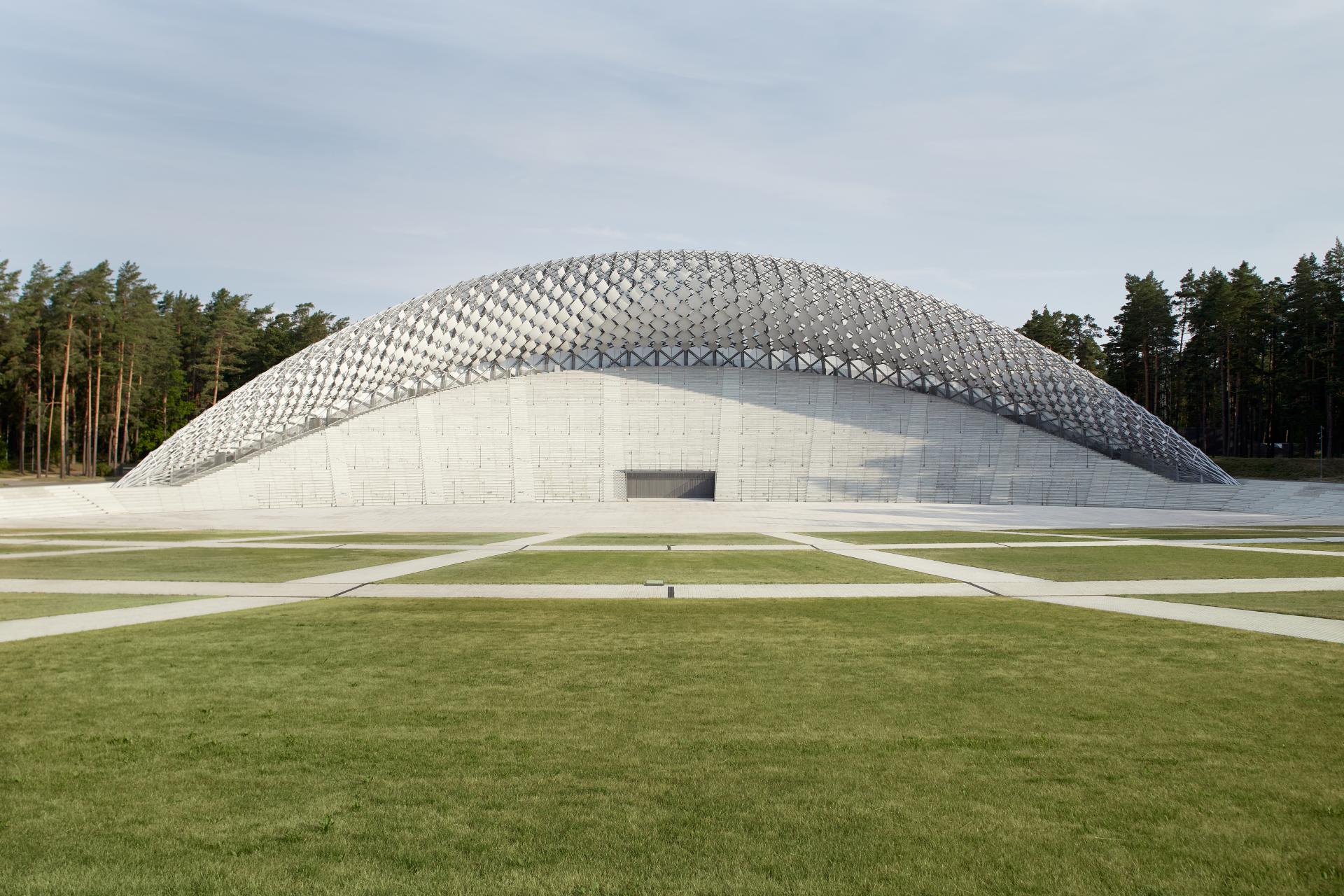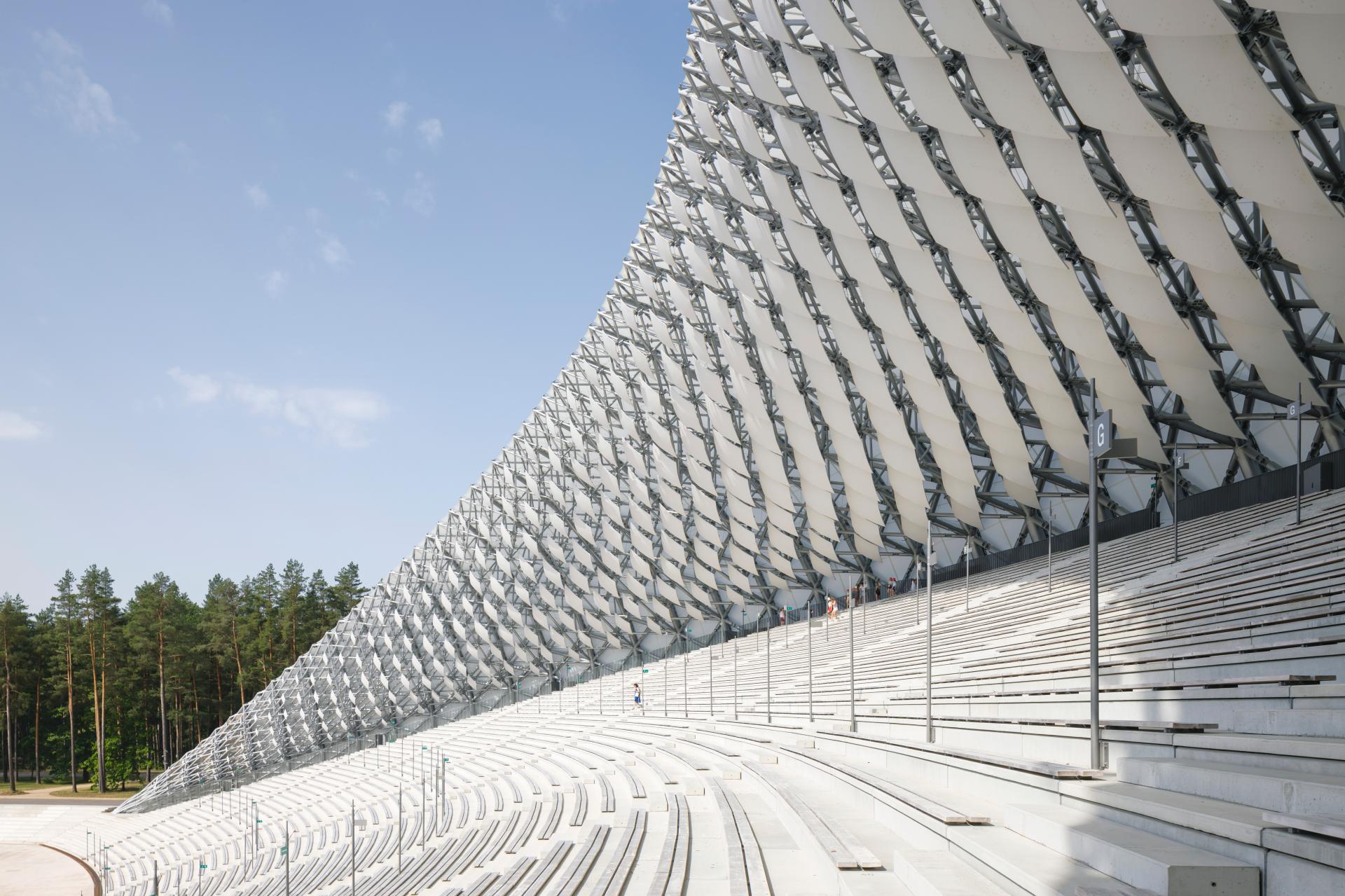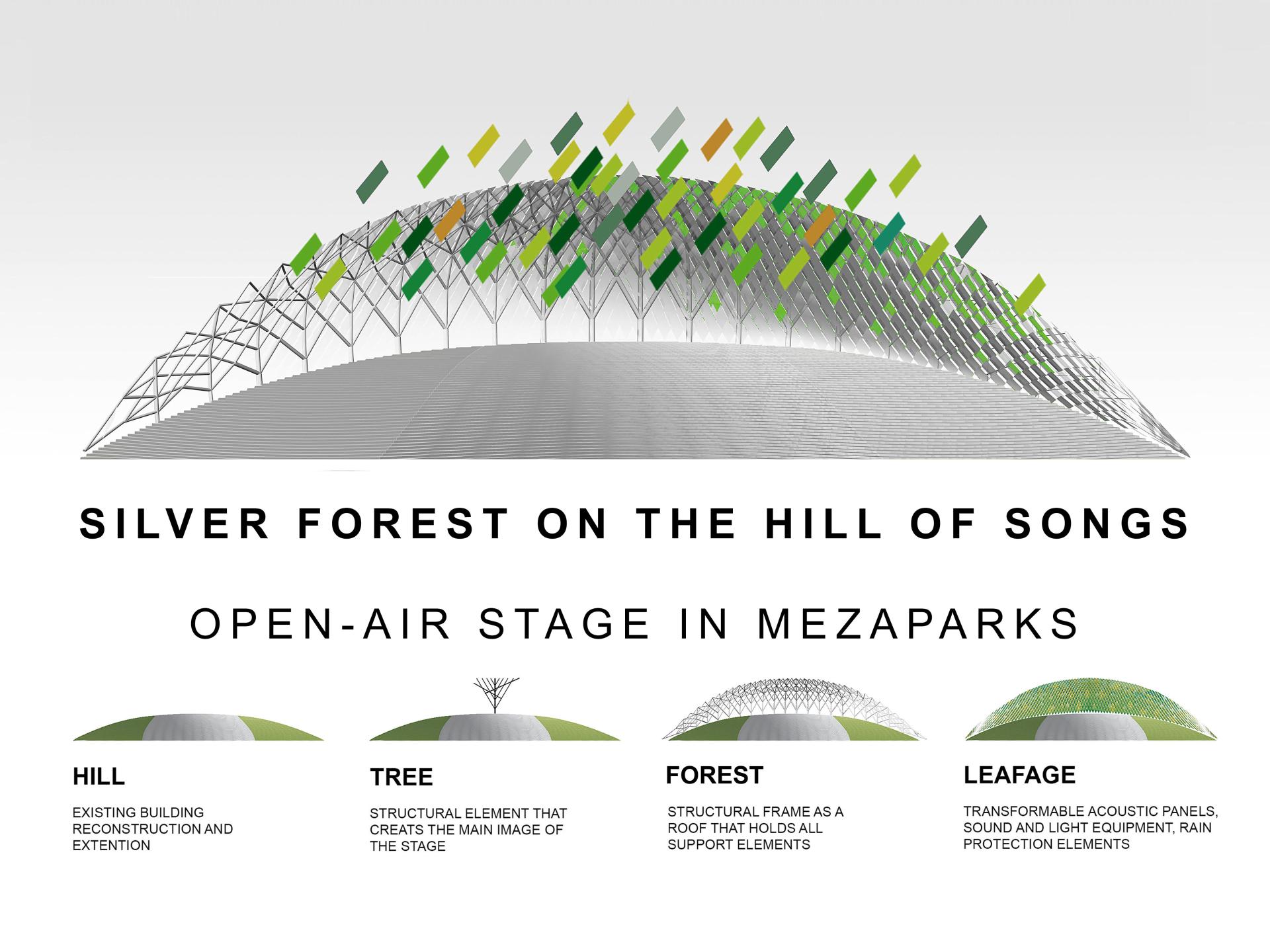Mezaparks Open-Air Stage
Basic information
Project Title
Full project title
Category
Project Description
Artificial forest for a choir of 20 000 singers is a venue for Latvian Nationwide Song and Dance Celebration which is a core cultural event in Latvia and is responsible for the development of national identity and unity. A unique building typology is designed specifically for large-scale acapella singing. The aesthetic and philosophical mythology of Silver Forest, rooted in ancient Baltic culture, learns from nature and sends the message of the possibility of an ecocentric and human world.
Geographical Scope
Project Region
Urban or rural issues
Physical or other transformations
EU Programme or fund
Which funds
Description of the project
Summary
Latvian Nationwide Song and Dance Celebration, which dates back to the late 19th century, is one of the largest choral events in the world and is responsible for the development of Latvian national identity and unity. It is included in the UNESCO Representative List of the Intangible Cultural Heritage of Humanity for its unique acapella singing which brings together a choir of up to 20 000 singers from all over Latvia.
The unique building typology is designed specifically for this large-scale choral performance. The New Reconstruction of Mezaparks Open-air stage replaced the previous stage which was built in 1955 under Soviet regime and no longer satisfied acoustic and safety needs. Inspiration was found in ancient Baltic culture and nature by applying an aesthetic and philosophical mythology of Silver Forest to solve capacity, structural and acoustic challenges and send the message of an ecocentric and human world.
Forest acoustics creates even and spacious echos making it one of the most suitable environments for a large-scale choral singing. The roof structure is designed as the leading acoustic element where separate columns grow together and form a spatially stable framework. Adjustable acoustic panels in the structure direct sound in the desired direction. Spatial analogy with the forest significantly improves the acoustic parameters of the amphitheatre and hones a natural and specific sound for a choir. Local singers and conductors have described it as a silver sound - unique for Baltics.
Open-Air Stage reuses adjacent infrastructure of existing forest roads and recreational areas. Venue is open daily as a centre for culture and leisure and provides adaptable space for various types of performances and events. Artificial forest lays harmonically in the landscape of a natural forest - a typical landscape of the Baltic coast. It's simple and democratic materials emphasise Baltic aesthetic tradition and the calm curved volumes resonate with dunes around it.
Key objectives for sustainability
Artificial forest lies harmonically in the landscape of a natural boreal forest. The landscape of the complex territory was regenerated with the purpose to preserve and restore the local forest ecosystem. Mezaparks Open-Air Stage reuses adjacent infrastructure of existing forest roads and recreational areas to preserve historical and natural resources.
Visible, structural, approachable materials are used to ensure efficient maintenance of the venue. Roof membrane protects structure and extends its longevity. Outdoor concrete elements are prefabricated with a quality surface that ensures the durability of the concrete. Metal constructions are made in the factory and their assembly took place on the construction site, which reduces the possibility of metal corrosion. Interior decoration of the premises is minimal, reducing the consumption of materials in construction, as well as minimising the need for repairs.
The extensive use of wood as a local renewable resource in window frames, finishes and local timber structures. Natural antiseptic preservation of timber has been applied in outdoor areas to ensure longevity for the material. In the audience and chorist tribunes, a large number of timber benches reduce heat output from the concrete base. A natural air circulation for singers has been provided by roof membrane opening between the choirists tribune and roof structure.
The venue is classified with an A energy efficiency class. Foam glass is used for thermal insulation, replacing traditional thermal insulation materials. Visitors' toilets are designed according to the passive design principles. The infrastructure is powered by renewable resources of wood pellets and eliminates the use of fossil fuels. Large rainwater tankers, storing rainwater from the area, provide water for lawn irrigation.
Key objectives for aesthetics and quality
The concept of Silver Forest on a Hill of Songs is formed in associations with the Latvian landscape and the wisdom from Latvian folk songs. The grandstand symbolises the hill on which to climb so that the song sounds far away, and the roof is shaped like a silver forest sung in folk songs - a symbol of light, clarity and protection. Relationship with nature, learning from nature is one of the leading themes in local folklore and culture. The animistic tradition is still common between Baltic people. The Silver Forest in Baltic mythology is a vital space for human and cultural ideas, values and relationships and expresses a Baltic philosophical identity.
The process of creating a work reinterprets the interaction of architecture, culture and technology with nature, learning from it directly. Forest mimicry creates a unique sound which the choir community calls a Baltic silver sound. It expresses Baltic aesthetic identity.
The work is cautiously designed in light, silvery tones to make the participants stand out against its background - their colourful national costumes, choir flags, the special design of each holiday and the scenery of the lights. The staging is like a background for choirs and people to stand out. There are no visually decorative elements here. Each of them has both visual and rational meaning. Uniqueness, scale and novelty can be invoked by describing the various components of this structure, but above all there is a visual purity of the image and compliance with the task, austerity, tonal discipline, authenticity and functionality of the materials which emphasises Baltic aesthetics.
The previous open-air stage was built in 1955 under the Soviet occupation regime. That architecture was formed by strong political ideology and symbolic values. The new stage emphasises returning to nature as a nation's cradle. Nature is a sacred and safe environment in the local mentality. It is where Baltic people belong.
Key objectives for inclusion
Latvian choir movement fosters the nation's unity and is a manifestation of human values and belonging. Most of the Latvians are related to this movement through choirs, dance collectives, orchestras, traditional artisanship and other activities. The project encouraged wide publicity and public discourse.
The reconstruction of Mežaparks open-air stage is a completed work on the award-winning design of the 2007 international competition. It is a result of a joint effort of public participation. Each element is uniquely designed and produced by an international team of architects, structural engineers, acoustic consultants and producers. Besides the architectural and expert team representatives of the Nationwide Song and Dance Festival - conductors, singers, dancers, musicians and members of the Latvian National Cultural Centre, were invited to take part in the project design process. The inclusion of various interdisciplinary parties in the design process has led to innovative technical and acoustic solutions.
The territory has been opened daily to the public for the first time as a centre for culture and leisure. It provides an adaptable space for various types of performances and events - acapella singing, rock-pop concerts, sports and culture events. The venue has been positively evaluated by non-governmental organisation Apeirons as an accessible space for people with disabilities.
Results in relation to category
Mežaparks Open-Air stage has become a community centre for most of the Latvians which invites to nurture the national self-confidence and responsibility for the preservation of the national cultural heritage, to be aware of the unique place of the Song and Dance Festival tradition in the scale of national and cultural values. To motivate the inhabitants of Latvia, especially young people, to get involved in the maintenance of tradition and build the future of the Song Festival movement, to sustain nature and to hone human values. A growing interest in young people in joining choir and dance collectives has been acknowledged.
The Mežaparks Open-Air stage gives an opportunity to any person in Latvia or the world to emotionally and authentically get to know and experience the unique phenomenon of the Latvian and Baltic Song Festival through the largest choir in the world, exploring its multiplicity, harmony and spiritual depth. The venue is designed with enlarged capacity to nurture the growing tradition. Acoustics are adapted for large-scale acapella singing and emphasises the unique sound of Baltics - silver sound. This sound brings together local Baltic people and diaspora from all over the world.
How Citizens benefit
The Mežaparks Open-Air stage is a cultural landmark of national importance and emotional attachment. Therefore, the reconstruction of Mežaparks open-air stage provoked a significant public interest and asked for a gentle and thorough approach in designing a new aesthetic and philosophical image.
Besides the architectural expert team representatives of the Nationwide Song and Dance Festival - conductors, singers, dancers, musicians and members of the Latvian National Cultural Centre, were invited to take part in the project design process. Public discourse and involvement were achieved by a wide and transparent publicity strategy. A high level of public participation and communication from diverse viewpoints was aimed to create a place with a strong sense of belonging, inclusion and inter-generational exchange.
Recently opened public territory has become a popular attraction point for locals and visitors. Upcoming Nationwide Song and Dance festival in 2023 is implementing the philosophy based on nature and humanitarian values in its scenography and repertoire. National institutions like the Ministry of Culture and Latvian National Cultural Centre have been using the mythology of Silver Forest in formation of Latvia's image and popularising the maintenance of tradition.
Physical or other transformations
Innovative character
The Mežaparks open-air stage is an innovative succession of choral complexes constructed in Latvia in terms of its scale and character. This unique typology has emerged from the very beginning of tradition. A new stage was built for every event thus the new typology developed very quickly in accordance with the development of the tradition itself. The open-air amphitheatre is a unique spatial structure in a global context consisting of an audience area, a singers’ podium with a sound-reflecting structure.
The project is an accomplishment of high functional and aesthetic quality allowing to enjoy an a cappella performance of more than 20 000 singers. Thanks to the acoustic solutions learned from nature, the sound is transferred from the choral podium to the audience area.
Biomimicry implemented through the use of new technologies has helped to find unique solutions in acoustic and structural challenges. Each element of the roof - both the metal structure that symbolises the branches and the wooden shields that symbolise the leaves - contributes to the acoustics. Spatial analogy with the forest significantly improves the acoustic parameters of the amphitheatre and hones a natural and specific sound for a choir - silver sound.
The use of new technologies as parametric programming has helped to embody the organic nature of a forest in a complex physical structure. All the elements implemented in the podium and acoustic roof are unique, because the building itself is atypical and irregular. The dome is based on 44 columns achieving a height of 35,80 metres. Each column has its own dimensions, each reinforced concrete step is unique, each has its own place. In order to ensure acoustics, 510 acoustic panels are attached to the roof structure of the metal dome. The shape and product of the acoustic shields is unconventional, it is a double-curved wood veneer, attached to an adjustable metal substructure.
Learning transferred to other parties
The project provides extensive research and design materials of the appropriate acoustic solutions in creating a unique outdoor venue with high capacity and acoustic parameters. The experience of the process of learning from nature has been used as a lecture material for local and international audiences on platforms such as RIBA Europa talk, Estonian Academy of Arts, Riga School of Design and Art.
The Ministry of Culture and Literature and Music Museum has created an institutional platform in Mežaparks Open-Air stage dedicated to the Nationwide Song and Dance festival. The exhibition is a multi-level story, which is sequentially expressed through spatial audiovisual experience, informative educational materials and the creation of an active social platform to promote public involvement. Additional exhibition has been developed by the project team and depicts the typological evolution of the buildings of the Nationwide Song Festivals. This exhibition also contains artefacts of previous stages and explains how this unique architectural tradition evolved and was maintained and developed in the new venue. The exhibitions aim to become a community centre which motivates people to get involved in the maintenance of tradition and build the future of the Song Festival movement.

